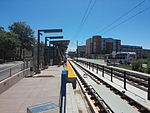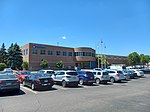U of M Transitway
The U of M Transitway is a busway that runs between the University of Minnesota's Minneapolis and St. Paul campuses. Use of the roadway is limited to buses, bicycles, and emergency vehicles. The University of Minnesota runs zero-fare buses along the busway connecting the two campuses, primarily the Campus Connector but also shuttles to and from the St. Paul campus for football games. A bicycle trail runs alongside the transitway for most of its distance. Between the endpoints, there are only two intersections with stoplights controlling busway traffic at Energy Park Drive and Como Avenue. The stoplights are designed to normally give the buses priority, so it is possible for many buses to run the length of the transitway without stopping.
Excerpt from the Wikipedia article U of M Transitway (License: CC BY-SA 3.0, Authors).U of M Transitway
University of Minnesota Transitway, Saint Paul Saint Anthony Park
Geographical coordinates (GPS) Address Nearby Places Show on map
Geographical coordinates (GPS)
| Latitude | Longitude |
|---|---|
| N 44.97429 ° | E -93.19953 ° |
Address
University of Minnesota Transitway
University of Minnesota Transitway
55108 Saint Paul, Saint Anthony Park
Minnesota, United States
Open on Google Maps







